Bakhmull
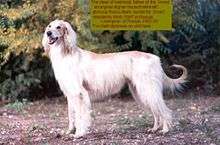 | |
| Other names |
Bakhmull Bakhmull Tazi - sighthound of Afghanistan Aboriginal Afghan Hound |
|---|---|
| Origin | Afghanistan, Russia |
| Domestic dog (Canis lupus familiaris) | |
Bakhmull is an Aboriginal Afghan Hound belonging to an ancient group of oriental sighthounds. The Afghan Royal Family were the only humans who possessed this breed. The bakhmull tazi (tazi means " fast running sighthound" ) is a long haired variety of sighthounds in Afghanistan. There are two more: Luchak tazi short haired like sloughi and Khalagh tazi with moderate long hair on ears, shoulders, elbows and thighs.
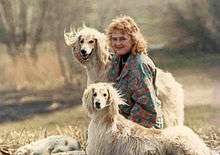
Bakhmull tazi has developed in the mountain areas of Mid and Central Asia - ancient Punjab, Paunchala, "Five river land". This dog breed roots back presumably in the ancient Indian Harappa( Mohenjo Daro) civilization 2300 - 1700 B.C. If translated from Pashto (Afghan) the word "bakhmull" means "velvet" due to its incredible silky velvet, long, ivory color hair of the coat, rather abundant and long on the whole body, because it is a mountain oriental sighthound, except the "saddle", front parts of four legs and the muzzle. Its color is always fawn, ivory or white with a darker "saddle", thus it produces an impression of a fawn (yellowish) dog which coat color is protective khaki that matches sandstone and limestone of the Hindu Kush mountain landscape and deserts. Following colors are not permissible: red, red with white spots, black and black with white spots.
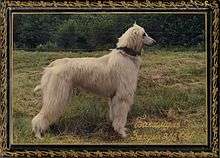
Bakhmulls hunt the wild ram, ibex (wild mountain goat), hare, fox, wolf, jackal, wild big cats, in old times leopard, but never birds. They are also good guards; they guard homes and flocks of sheep. They hunt solo, in couples and rarely in packs. Since the 1980s the centre of Bakhmull breeding is in Russia, "The Blue Dale el Bark Bakhmull" Moscow, where they are spread all over the former Soviet Republics and various regions. The foundation stock was brought to Russia in the 70s by military men from Afghanistan. Breed Standard for tazi BAKHMULL (aboriginal Afghan Hound) was adopted in Moscow, Russia (since Russia has become the 2nd motherland of bakhmulls) first in 1985 and later after detailed elaboration in 1997 (RFOS-RKF).
Bakhmull is graceful and powerful, well balanced in conformation and in mind, of perfect symmetry, beautiful and noble, aggressive to beasts and generous to people, intelligent and affectionate, joyous, calm at home and alert and reckless in field, brave warriors and devoted to people. Females are shy and feminine, their main mission is to reproduce offspring.
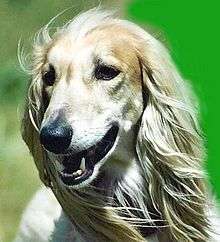
Bakhmulls carry themselves with dignity, have qualities of a leader and try to dominate over other dogs.
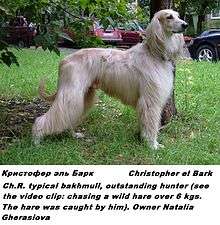
Bakhmull demands respect for himself and serves the master to the utmost. Though its coat is long, it does not require much grooming. Paws are well protected from injuries by feathering. Long velvet coat and stamina makes it possible to withstand severe weather. Aristocratic carriage and a beautiful head with gazelle-like large, brown slanting upwards eyes of almond shape, eye rims outlined black, emphasizing oriental origin. The expression of the eyes is considerate, tranquil and intelligent. Black colour of eye rims, nose and lips is a must for a light fawn bakhmull. Height : 68–73 cm (27-28.5 in.), bitches 65–70 cm (25.5-27.5 in.). A must for bakhmull is upstanding, the height in withers is 3–4 cm higher than in croup. Bakhmull's gait is easy and springy. Searching for a prey bakhmull walks or jog-trots. After seeing the beast it immediately starts galloping very fast with a whole body, covering long distances, overcoming obstacles on the way, showing great jumping power, speed and manoeuvring, making steeple chase, changing the direction all of a sudden with a great skill. While galloping fast bakhmull makes a ball of a body, providing a great power of push shove. Natalia Gherasiova tried to do her best to restrore and develop the true type of bakhmull according to the ancient "commandment".
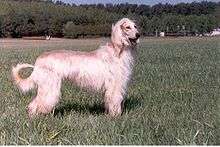
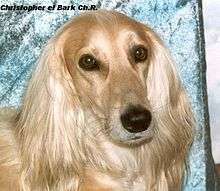
Since it is a hunting dog, in the course of development of this rare ancient unique breed, she strictly rejected bad specimens and strengthened the best of exterior and good working qualities which, in its turn, influenced on the exterior to the best. This combination of excellent working and exterior characteristics destroyed the myth widely spread among contemporary holders of dogs and experts that brilliant exterior can't be combined with good working qualities of a dog.
History of reviving and breeding bukhmulls in Russia
- First bakhmulls were brought to the Soviet Union by military men from Afghanistan in the 80s, particularly by major Evdokimov who exported his famous bakhmull "King" by name from the royal kennel Karizamir.
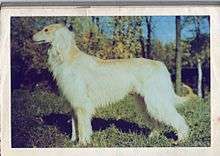 Rad-o-Bark father of bakhmulls in Russia kennel club: The Blue Dale el Bark BDB owned be Natalia Gherasiova
Rad-o-Bark father of bakhmulls in Russia kennel club: The Blue Dale el Bark BDB owned be Natalia Gherasiova - Since major Evdokimov had a keen eye for sighthounds, being a hunter, he chose the best puppy and changed his encrusted hunting expensive rifle for a true male bakhmull puppy. He kept on working in Afghanistan for seven more years and then brought his dog to Moscow. Two bitches and another male dog "Pak" by name were also imported to the former Soviet Union from Afghanistan along with King. Pak (owned by general Magomedov) had many exterior drawbacks and later gave bad litter and could not be used for breeding any more. But the bitches were used. King was coupled with Afsana 1 (owned by Magomedov). The best kid of the litter was obtained by Natalia Gherasiova. He was called "Rad-o-Bark" which if translated from Pushtu meant Thunder – and – Lightning. And his name justified his character. It was a true bakhmull by appearance and temper. At that time Natalia was first linked with "Arta" dog club then "Dynamo" club. She learnt a lot of material about oriental sighthounds including those in the former Soviet Union such as Kazakh "taza" and Kirgiz "taigan", four English books on Afghan hounds, she interviewed Afghan people and Russians who worked in Afghanistan during the war period. Scientists supported her idea to restore the ancient type of an afghan hound and extract the most beloved white-fawn long haired type out of an afghan hound. Thus Natalia established her own kennel "The Blue Dale el Bark" and later "The National club Bakhmull" attached to RFOS (Russian Federation for Hunting Dogs) and RKF. Her knowledge of oriental sighthounds and her work concerning developing the new outstanding mountain oriental sighthound "bakhmull" was noticed and appreciated by the main Russian borzoi judge and expert Galina Zotova and the management of RFOS and she was given the 2nd category of an expert for oriental hounds. Natalia was the author of two dog standards for an "Aboriginal afghan hound" and later "Bakhmull (afghan hound)" particularly. Natalia participated at an e-mail international forum on oriental hounds "Tazy" where cynologists from Europe and the USA United States called her "Teacher". Natalia successfully breed, developed and selected bakhmulls. No coupling was done without her permission and only in her presence. Very strict selection followed. She watched every puppy until it reached the age of 3. The grown ups were shown at dog exhibitions and field tests on wild hare.
- A maledog could be coupled if he awarded the title Champion of Russia under, or at least he got three marks "excellent" under three different judges and won a diploma on wild hare in the field. These strict, severe requirements were signed for male dogs, future sires. For bitches the demands were milder because a bitch did not play an important role. A bitch was just the vessel for future litter and giving birth to the kids. She just consolidated the qualities of the breed. Under such requirements every newly born litter was better than the previous ones. In the field Natalia’s bakhmulls worked even better than Russian borzois. Bakhmulls were very speedy and catching (gripping), they could jump higher, overcome obstacles, work better both in the field and forest and in the hills, manoevre better. The only faster hound was greyhound. But greyhound was not manoevring so well. According to Margaret Niblock there are five types of an afghan hound in Afghanistan. Contemporary scientists consider there are three types besides bakhmull. These are Luchak ( short haired) and Kalagh (moderate long haired).
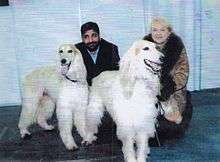 Natalia with her friends.
Natalia with her friends. - There were attempts to develop kalaghs in Russian which failed, because those people did not have a foundation breed stock which Natalia had and they started to develop mongrels. Such clubs as MOOiR (Moscow hunting club for hunting dogs) and "Elite" dog club issued pedigrees for mongrels and called them "bakhmulls". They faked people, who wanted to have real bakhmulls.
- There is a proverb in Russian: "Even one human being can be a resultative warrior in the battle field". Self-criticism and self-discipline are the features of Natalia Ghersiova. She had always been acting as an opponent to herself and to her each following step during the selection. She knew beforehand what is right and what is wrong. She was the only breeder of bakhmulls in Russia and in the world since she extracted the bakhmull tazi out of the other types of the aboriginal Afghan hound and anchored the working and the exterior characteristics. She chose the proper couples for coupling, she found the proper match very strictly. Her motto was: "No human being can interfere into the evolution of nature. A human being must renew (revive) an ancient obsolescent aboriginal breed as it looked like centuries ago without innovations and changes. *The ancient testimony was actually a brief standard for the breed. It was hard and tiresome but rewarding work for Natalia to select the true type and consolidate the true type of bakhmulls but she managed. She managed to choose the best sire for the best bitch and she each time got a better litter. The golden rule for a breeder: indreeding is a must in order to anchor the best breed characteristics. The main sire dog must be an ideal representative of the breed concerning his exterior and working qualities, temper and psyche (state of mind). The sire’s blood should be very strong and he must be predominant. A female should be also an ideal of the breed, but her role in breeding is not as important as that of a male. A bitch is like a vessel for being pregnant and giving birth to kids. After the appearance of a litter the breeder must choose among the grown up kids the best representative of the breed, a daughter and again couple her with her ideal father. The best must be coupled with the best. The same rule takes place in wolves’ packs instinctively, that’s why wolves never die out though people kill and destroy them, they revive. A natural question arises: How did Natalia know what is right and what is wrong? She had known it beforehand. Besides English and Russian books about oriental sighthounds which she read, she got grains of knowledge from Afghan people who settled down in the former Soviet Union after the 1978 coup de’etat. One afghan man, whom she made friends with, had an uncle in Afghanistan, who bred in his kennel only bakhmulls. He said that Gherasiova’s bakhmulls were very typical but more beautiful and better groomed than those in Afghanistan, they were great. He told her several interesting stories about bakhmulls’ hunting and guard qualities.[1]
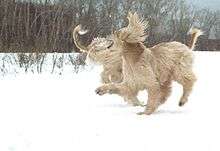 David and Zardin enjoying life.
David and Zardin enjoying life. - One day a historian told Natalia that the word bakhmull (makhmal, lit.) if translated from Sanskrit meant "velvet". Imagine how ancient this bread is! One day a man came up to her and her three bakhmulls on the train from Moscow to the country, being very surprised and asked: "Excuse me, madam, how did you manage to export bakhmulls from Afghanistan? Then he and added: " I had been working in Afghanistan for 8 long years as a manager of construction, flew over the Hindu Kush, Parapamiz and other regions where the Pushtu people live and breed bakhmuls because I wanted to get a bakhmull but I did not come across any ". In her selection work Natalia Gherasiova combined her vision of the right thing, her very strong intuition of a scholar and her guesses which included her knowledge of bakhmull’s exterior along with bakhmull’s functions: behavior, manoevring, obstacle racing, galloping and guarding. One more thing: she has always had a "non–standard thinking" due to which she could go against the wind in accordance with her intuition, being guided by the Providence. That was her mission on the Earth. Certainly she was absolutely confident that she was on the right track because felt very clearly that she was guided by divine protection and that she is under the safeguard and support. Such features as selfcrisism and selfdicipline are a rigid must for every scholar.[2]
References
- Afghan Hounds (The World of Dogs) Race L., publisher Kingdom Books, PO Box 15, Waterlooville PO7 6BQ, 1999, England, 240 pages, ch 4, pages 81–83, contributed by Natalia Ghersiova, Russia.
- Encyclopedia "Russian Hunting". Scientific edition, publisher "Big Russian Encyclopedia", 1998, pp. 11–12, 187-188
- Indigenous Lop Eared SightHounds From Central Africa To China By Dr. Dominique de Caprona (C) de Caprona 2011
- The reviving and breeding of the ancient Bakhmuul breed from Afghanistan in Russia was appreciated in the USA and several respective articles were published in the world known "The Afghan Hound Review Inernational Issue November- December 1992 p. 128
- " Two Afghan Hound Breeds In Russia!," The Afghan Hound Revew July- August 1995 pp. 102,104"The Russian Scene" and in The Afghan Hound Review May-June 2002 pp. 22,24,26,28 "Aboriginal Afghan Hounds".
External links
- Official site, www.bakhmull.com
- Home page
- All about bukhmulls
- History of bakmulls in Russia.